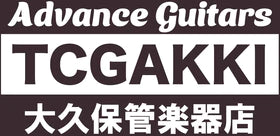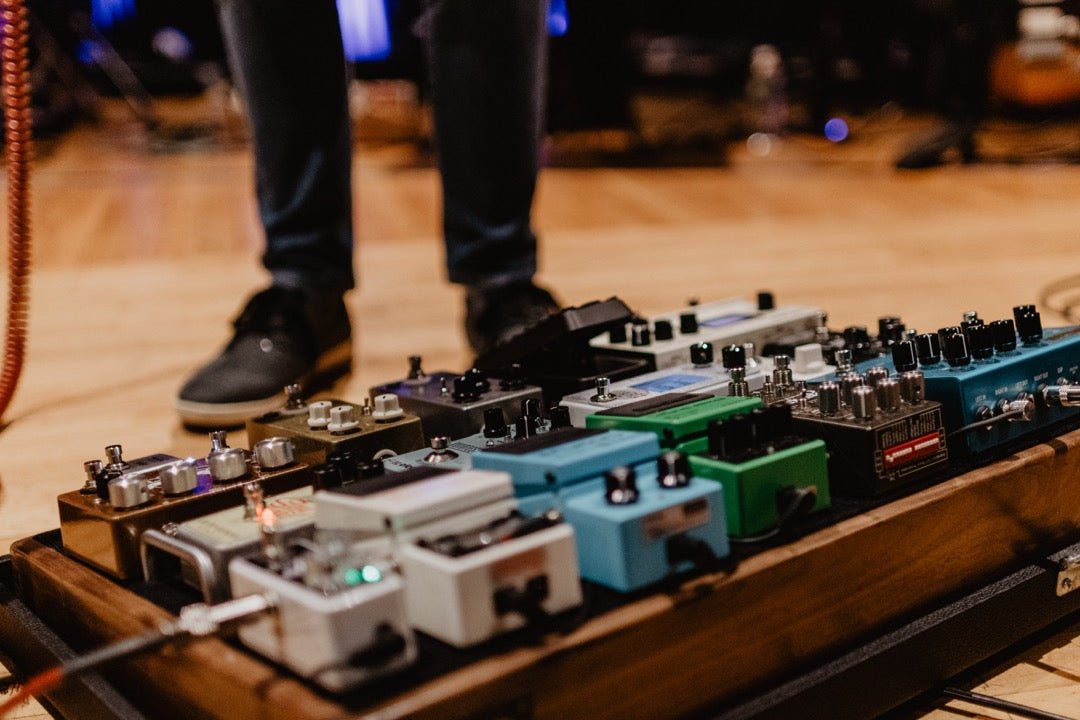
So, you've got the electric guitar and amp you've always wanted! Now you're ready to try out some songs by your favorite artists. What's that? (-...) It's not right... It doesn't sound like the sound you can hear on CDs or at live shows!

Effectors are tools for processing sounds and adding special effects to enhance expression. There are many types of effectors. The most popular type of effector is probably the distortion type (hissing type).

The appeal of an effects pedal is that it allows you to create a sound that has a lasting impact on the ear, or to create your own original sound. Of course, there are also more professional uses, such as hidden effects and sound correction.
Here, we have compiled a list of basic information on effectors, including types of effectors, how to connect them, common problems that can occur, and tips on how to use them.


|
Along with fuzz and other effect pedals, effect pedals have existed since the early days of effect pedals, and were originally developed to reproduce the muted playing style of trumpet players. By operating the filter with the pedal, you can move the peak frequency from high to low and get tone changes such as "wah-wah" and "wah-wah". The sound is controlled by how fast and how deep you move the pedal. |
|
|

|
This is a filter type effect pedal that actively creates sound quality and tone, and corrects the sound. There are two types of filters: graphic equalizers (Glyco) and parametric equalizers (Parayco). The "Glyco" type has filters for each frequency (band) lined up in a straight line and is easy to understand visually (graphically) like a frequency graph. On the other hand, the "parayco" type changes the tone by setting the center frequency, level, and bandwidth respectively. It is a little difficult to understand, but the final effect is the same for both types of instruments, despite the differences in the way they are operated. The so-called "don-shari" sound is created by using an equalizer to reduce the mid-range and emphasize the low range and high range to create a fuller sound. |
|
|

|
The filter is activated according to the input signal level to create a dynamic and percussive wah effect. |
|
|

|
As far as history goes, "fuzz" first appeared in the 1960s. They had more unique sounds, ranging from cheap sounding ones that sounded like a broken transistor radio, to ones that distorted intensely and produced amazing sound extension. Later, in the late 1960s, Eric Clapton's "Woman Tone," created with a Marshall amp and Les Paul guitar, attracted a lot of attention. This was an "overdrive sound" obtained by overloading a tube amp with the volume turned all the way up. Then, instead of the extreme fuzz of the past, "distortion" appeared, which was more natural and allowed the guitarist to express himself more subtly. In the late 70's, "overdrive" appeared, which was closer to the natural "overdrive sound" of a tube amp and guitar, and offered more expressive power. It is easy to understand if you remember that light and natural distortion is called "overdrive," intense and heavy distortion is called "distortion," and more intense and distinctive distortion is called "fuzz. |
|
|

|
It is also called phaser. Originally, these effectors were invented to reproduce the Leslie speaker, a device that produces the Doppler effect. However, the effect is not the same and has been established as an independent effector. As the name implies, phase-shifted signals are added to the original signal to create interference and give the sound an undulation effect. The effect varies depending on the number of stages in the phase shift circuit. In contrast, a vintage sound with fewer stages is characterized by a loose, coarse sound. |
|
|

|
A booster is an effect pedal that simply increases the volume, and is called a "clean booster" when it amplifies the original sound without changing it. Boosters make it possible to overdrive an amp without difficulty, even with a guitar of low output. A preamp controls tone and volume and can also be used as a booster. |
|
|

|
It is a pulse caused by a volume change and was an effect often found in vintage amplifiers. The effect obtained varies depending on the waveform of the signal and the speed of the change, and can range from a gentle effect to an intense machine gun-like effect. |
|
|

|
The effect is similar to a phase shifter, but in terms of circuitry, it is a member of the delay family. By adding modulation to a short delay, you can get jet effects that are more aggressive than phase shifters, or fluctuations that have a stronger sense of modulation than phase shifters. |
|
|

|
Like the flanger, this effect pedal adds modulation to a short delay to create a faint shimmering effect. It is characterized by a shorter delay time than the flanger and produces a pleasant and refreshing effect. Recently, digital type products have been replacing analog type products that use BBD elements. |
|
|

|
The effect is generally obtained by oscillating the pitch up and down, as is known in guitar playing. Some phase shifter circuits and chorus circuits are used to achieve the same effect audibly. |
|
|

|
This is the so-called "Yamabiko effect. A delayed sound is added to the original sound. Various effects can be obtained depending on the delay time and the number of repetitions. Depending on the structure, there are different types of delays such as tape echo, analog delay, and digital delay. Each has its own distinctive sound. |
|
|

|
It is difficult to tell the difference from delay/echo, but this one refers to "reverberation" or "reverberation." For example, when you sing in the bathroom and it sounds good, it is exactly the reverb effect. Originally, spring reverbs built into amplifiers were the norm, but nowadays, digital reverbs can easily produce a wide variety of reverb effects, including hall, room, plate, gate, and the aforementioned spring. |
|
|

|
It uses a VCA (Voltage Controlled Amplifier) circuit, which, as the name implies, compresses (crushes) the sound and stretches it. Not only does it extend the sound, but it also gives the sound a unique moment of attack when the strings are plucked, giving the sound a tautness. A limiter also compresses the sound in the same way, but this one has the effect of suppressing only the peak signal. It is a more compensatory effector. In recording studios, the rack type using vacuum tubes is the most common type. |
|
|

|
These devices are used to reduce noise and shut out the signal when not being played to prevent noise from entering the signal. However, they are not perfect, so it is important to set them up so that they do not affect the tone, and most importantly, to eliminate the source of the noise, such as the guitar, amplifier, and shielded cables. |
|
|

|
There are two types of harmonic and phased equalizers, and they have the effect of bringing out sounds that tend to be buried in the ensemble. Unlike equalizers, they have little effect on the original sound. |
|
|

|
The most radical effect pedal? By mixing the built-in transmitter with the guitar signal, you can create unpredictable pitch changes and unique sounds such as rings and metallic sounds. |
|
|

|
It reproduces the sound of a guitar amp, making it easy to obtain realistic sounds for recording and other applications. The original amp simulators, such as Tech21's SansAmp and Line6's POD, are well known. The latter offers a wide variety of amps and cabinets, and allows for precise settings, from mic'ing to effects. |
|
|

|
They can reproduce the unique fretting and overtones of an acoustic guitar, turning the sound of an electric guitar into that of an acoustic guitar. It is an easy way to introduce the sound of an acoustic guitar without having to switch instruments at live performances. |
|
|

|
A pitch shifter is an effect pedal that changes the pitch of a note, and its evolution includes the "harmonizer" and "whammy pedal. Although octaver with analog circuitry does not allow free pitch conversion and lacks tracking stability, it is popular for its distinctive and tasteful tone. |
|
|

|
Originally developed for steel guitar players in country music, the volume is controlled by pedal operation. It can also be played like the bowing technique of the violin, where the attack is muted and the sound emerges. |
|
|

|
Some effect pedals can change instruments by switching the input signal, change amplifiers by switching the output signal, or switch multiple effect pedals at once by creating a signal loop. |
|
|

|
1. compact type Foot pedal type. Compact and portable, most of them are battery-operated. |
|
|
|
Rack mount type Mostly used in studios and professional-use equipment, many of them are high-quality, highly functional products. On the other hand, they are large in weight and size, making them cumbersome to move. |
|
|

|
By efficiently setting up a large number of compact effectors on a board, setting up and transporting them becomes easier, and wiring and power supply-related problems can be prevented. |
|
|

|
So-called "all-in-one. An "all-in-one" combines multiple effectors and switching systems into a single unit. Generally, the combination of effects can be stored in memory, which is useful for live stage performances. It is also recommended for beginners to get acquainted with a wide variety of effects. On the other hand, the order in which effects are connected and the flexibility to insert other compact effectors into the system is limited. |
|
|

There is no absolute order, as effects can change depending on the order of connections. This is just a general setting example. There are some exceptions, such as vintage fuzzes that may not work properly if not connected from the guitar first.


|
Although it is not an effect, flying the guitar signal over the airwaves allows free staging unrestricted by shielded cables. It consists of a transmitter that sends the signal and a receiver that receives it. |
|
|

Surprisingly often, batteries run out! Digital effectors in particular consume a lot of power and can run out in a matter of seconds. If you use an AC adapter or power supply, you can save money on batteries and avoid running out of sound during live performances. If you use an AC adapter or a power supply, you can save money on batteries and avoid running out of sound during a live performance. But don't forget to pay attention to the voltage, polarity, and amperage rating of the adapter!
Use the best quality shielded cables you can find to reduce noise. In the unlikely event that there is no sound, do not panic and calmly look for the source of the problem. You can also avoid problems by cleaning the input/output terminals of effectors and shield plugs on a regular basis.































